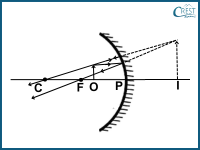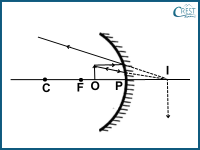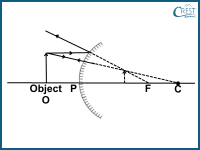1. A real object is placed 30 cm in front of a convex mirror with a focal length of 20 cm. What is the nature and position of the image formed?
a) Virtual, erect, magnified and -12 cm behind the mirror
b) Real, inverted, magnified and 12 cm in front of the mirror
c) Virtual, erect, diminished and 12 cm behind the mirror
d) Real, inverted, diminished and -12 cm in front of the mirror
Answer: c) Given data:
Object distance (u) = -30 cm (negative because it's in front of the mirror)
Focal length (f) = 20 cm (positive because it's a convex mirror)
We can use the mirror formula to find the image distance (v):
1/f = 1/v + 1/u
Substitute the known values:
1/20 = 1/v + 1/-30
1/v = 1/20 - 1/-30
v = 12 cm
Since the value of v is positive, the image is virtual and erect and located behind the mirror.
The magnification (linear) can be calculated as:
m = - v/u
We found that the image distance (v) is 12 cm, and the object distance (u) is -30 cm (negative because it's in front of the mirror).
m = - 12/-30
m = 2/5
So, the magnification (m) of the image formed by the convex mirror is 2/5 or 0.4. This means that the image is 0.4 times the size of the object, and it's diminished.
2. A makeup artist uses a concave mirror to apply makeup to a client's face. To achieve a highly magnified view, where should the client's face be positioned relative to the mirror?
a) Closer to the mirror than the focal point
b) Beyond the centre of curvature of the mirror
c) Closer to the client's eyes than the mirror
d) Parallel to the principal axis of the mirror
Answer: a) To achieve a highly magnified view when using a concave mirror, the client's face should be positioned closer to the mirror than the focal point. This positioning creates a virtual, upright, and magnified image of the client's face, making it easier for the makeup artist to apply makeup with precision.
3. In a concave mirror, an object is placed between the focal point (F) and the mirror's surface. Which of the following diagrams regarding the formation of the image is correct?
a) 
b) 
c) 
d) 
Answer: a) When an object is placed between the focal point (F) and the surface of a concave mirror, the image formed is virtual, erect, and located behind the mirror. The image appears to be on the same side as the object, and it is larger than the object. It is also formed by extending reflected rays backwards until they converge as depicted by the image in option a.
4. A student conducts an experiment using a concave mirror and finds that when the object is placed between the focal point (F) and the mirror, a virtual and erect image is formed. What can be concluded about the focal length of the mirror?
a) The focal length is positive.
b) The focal length is negative.
c) The focal length is zero.
d) The focal length cannot be determined from the given information.
Answer: b) When a concave mirror forms a virtual and erect image, it indicates that the object is placed between the focal point (F) and the mirror's surface. For a concave mirror, the principal focus (F) is real and located in front of the mirror. Distances measured in the opposite direction to the incident light (from right to left) are considered negative. Therefore, the focal length of the concave mirror is negative.
5. In an experiment, a concave mirror is used to form a real and inverted image of an object. If the height of the object is 4 cm and the height of the image is -2 cm, what can you conclude about the magnification and the nature of the image?
a) Magnification is negative, and the image is virtual.
b) Magnification is positive, and the image is real.
c) Magnification is negative, and the image is real.
d) Magnification is positive, and the image is virtual.
Answer: In this experiment using a concave mirror, the negative height of the image (-2 cm) compared to the positive height of the object (4 cm) indicates that the image is inverted relative to the object.
The magnification (M) can be calculated using the formula:
m = h2 / h1
where h2 is the height of the image and
h1 is the height of the object
Plugging in the values:
m = (-2 cm) / 4 cm = - 0.5
Since the magnification (m) is less than 1, it indicates that the image is real and inverted.





